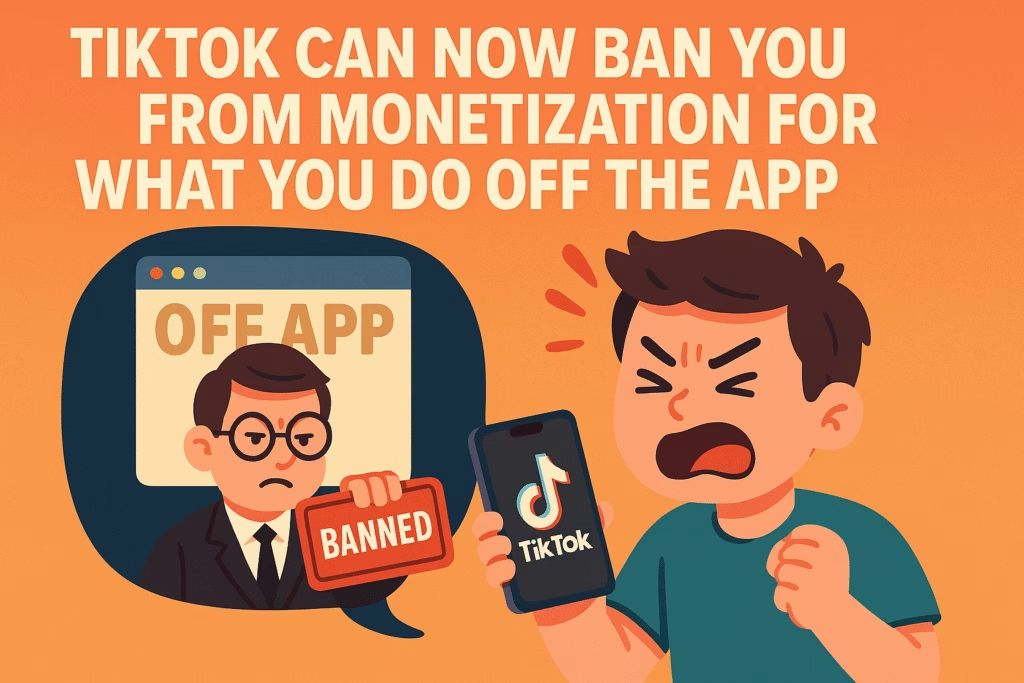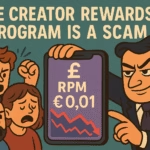Being a creator on TikTok used to be simple.
Post great content. Grow your audience. Join the Creator Fund or Creativity Program. Get paid.
But now, TikTok has flipped the script.
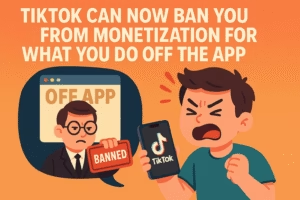
It’s no longer about just what you do on the app. TikTok is now evaluating your behavior off-platform — and if they don’t like what they find,TikTok can ban you from the monetization program. No warning. No transparency. No appeal.
We’re talking about browser activity, comments on other platforms, political views, and even your past behavior from years ago suddenly being used against you. Welcome to the era of social surveillance — and TikTok is leading the charge.
Let’s break down what’s actually happening, what creators are saying, and what you can do to stay one step ahead before your revenue vanishes overnight.
TL;DR: TikTok’s Off-Platform Monitoring Is Killing Monetization
-
Creators are reporting removal from monetization programs based on off-platform behavior.
-
TikTok can track your browsing activity, comments, and content across other platforms.
-
There’s no clear policy explaining what triggers removal — and no real appeal process.
-
The system is targeting creators that TikTok deems non-brand-safe or controversial.
Diversify fast: platforms like YouTube and Facebook still rely more on content than control.
This Isn’t a Conspiracy — It’s Already Happening
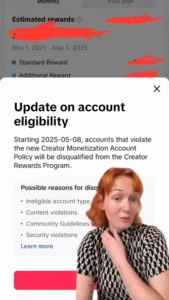
Let’s get one thing clear — this isn’t some tinfoil-hat rumor floating around Reddit. It’s already happening to real creators. Tiktok can ban you from the monetization programs not because of what you posted on TikTok, but because of what you said or did somewhere else. That’s not speculation. That’s firsthand testimony from creators who’ve been booted for things they didn’t even realize TikTok could see.
One creator posted about losing monetization shortly after sharing a controversial opinion on Instagram. Another was removed after uploading the same content to YouTube first — content that TikTok apparently flagged as “stolen” even though it was their own. Others are reporting that comments from years ago, or their involvement in topics TikTok deems too “divisive,” are now triggering automatic reviews and removals.
No explanation. No proof. No way to dispute it.
This isn’t about protecting users from harm anymore. This is about controlling the image of the platform. TikTok is trying to become as brand-safe as possible, and that means cutting ties with anyone who even smells like a reputational risk — even if that risk is something they said in 2017, or a meme they reposted on X.
If you think TikTok doesn’t have access to that level of data, think again. The app runs deep tracking scripts in your browser. It fingerprints devices. It cross-references your behavior across multiple accounts. And if you’re logged in while browsing, it’s already watching you.
Monetization Now Has a Moral Score — And You’re Not In Control
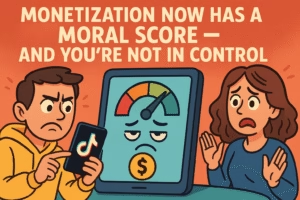 What used to be a numbers game — views, likes, watch time — is now something much murkier. It’s no longer enough to create clean content. You need a clean reputation. And not just on TikTok — everywhere.
What used to be a numbers game — views, likes, watch time — is now something much murkier. It’s no longer enough to create clean content. You need a clean reputation. And not just on TikTok — everywhere.
This is the quiet rollout of a social credit system disguised as monetization policy.
TikTok wants advertisers. Big ones. Safe ones. And to attract them, they need creators who are bland, predictable, and non-controversial. So the algorithm doesn’t just ask, “Is this content okay?” It asks, “Is this person okay?” If the answer is anything short of perfect, you’re gone.
That’s how we got here — where creators are losing income not for breaking rules, but for having opinions. Or for following the wrong person. Or for making edgy content on another platform. You might never know what crossed the line. TikTok certainly won’t tell you.
The worst part? You can’t game this system. Because it’s not about content anymore — it’s about control. You could be posting wholesome dog videos and still get flagged if TikTok’s surveillance decides you’re “not brand-safe.” It’s invisible, retroactive, and completely unaccountable.
Creators are now forced to self-censor everywhere or risk getting cut off from revenue they’ve worked months to build. It’s exhausting. It’s manipulative. And it’s the beginning of a trend other platforms will likely follow if it works.
Why Diversification Isn’t Optional Anymore
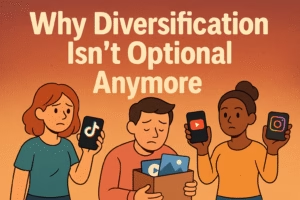 If you’re still betting everything on TikTok, you’re playing a game that’s already rigged against you.
If you’re still betting everything on TikTok, you’re playing a game that’s already rigged against you.
Gone are the days when you could go all-in on one platform, grow a following, and live off the algorithm’s generosity. Today, TikTok can shut off your income not because of something you did wrong on TikTok, but because of something you posted on another app — or even a joke you made two years ago. That’s not just risky. That’s reckless.
The smart creators? They’ve already diversified. They post on YouTube Shorts, Facebook Reels, Instagram, even Pinterest and email lists. Not because those platforms are perfect — but because they’re separate. They spread risk. If TikTok cuts your monetization, you’ve still got options. If Instagram buries your reach, you’re not financially dead.
The creators who refuse to diversify are the ones who end up crying into their drafts folder when their videos suddenly stop earning. They’ll say, “I don’t know what happened.” But the answer will always be the same: you built a business on rented land and forgot the landlord could kick you out at any time — for any reason.
And if TikTok’s now judging your off-platform behavior to decide if you’re worthy of income, then platform loyalty is officially over. This is a surveillance economy, and the only way to survive is to decentralize your brand.
How to Future-Proof Your Content Business (Before It’s Too Late)
Let’s be real. If TikTok can yank your monetization for something you did off-platform, then the platform was never yours to begin with. And if you’re still treating it like a reliable business partner, you’re one policy update away from losing everything.
It’s time to get strategic.
The only way to stay in control is to own your audience and distribute your risk. That means building an email list. Launching a site. Reposting to platforms that don’t nuke your income without warning. Using tools that give you clean separation between your accounts and your personal activity — like Social Proxy if you’re managing multiple brands or just want to stay off TikTok’s radar.
Start by reposting your videos to YouTube Shorts and Facebook Reels. Those platforms have their own flaws, sure, but they’re not yet judging your off-platform opinions like a digital morality police.
Second, move your most loyal followers to something you control — a Substack, a Telegram group, a personal site, anything with direct access. That’s your insurance policy. Because TikTok may own the traffic, but they don’t own the trust. You do.
And finally, start treating platforms like tools, not homes. Be ruthless. Be mobile. Be unbannable.
Monetization Is Now Surveillance — Adapt or Get Erased
What TikTok is doing isn’t just policy. It’s precedent.
If a platform can decide that your off-platform behavior disqualifies you from earning, then monetization is no longer based on value — it’s based on compliance. It’s not about creating good content. It’s about being controllable.
This is surveillance disguised as safety. A moral scoring system dressed up as brand protection. And the scariest part? It’s creeping in without resistance because most creators are too busy chasing views to notice their leash getting shorter.
So here’s the move — stop hoping platforms will play fair. They won’t. Take control of your content, your audience, and your revenue before the next invisible rule wipes out your income overnight.
Because the question is no longer, “How do I grow on TikTok?”
It’s “How do I keep what I’ve built when TikTok decides I don’t belong?”
